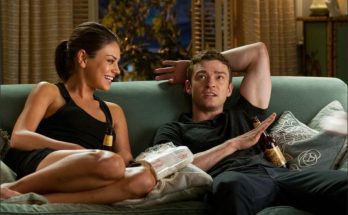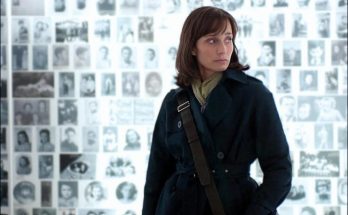Taglines: Is this man our next president?
The Ides of March takes place during the frantic last days before a heavily contested Ohio presidential primary, when an up-and-coming campaign press secretary finds himself involved in a political scandal that threatens to upend his candidate’s shot at the presidency. Also starring George Clooney, Paul Giamatti and Philip Seymour Hoffman.
“I would call this movie a political thriller. I wouldn’t think of it necessarily as a political movie,” says George Clooney, who directs, produces, co-writes, and stars in The Ides of March. As it focuses more on process than platform, Clooney says that the story will appeal to members of both parties. “I suppose if you’re a Democrat you’ll like the beginning of the movie best, and if you’re a Republican you’ll like the end best. It walks that line of picking on everybody. If it is a political movie, it’s a political movie without pressing a specific agenda, and that was what was important to us.” In that way, politics serves as a backdrop to the character arc and changes in motivation experienced by the main character, an idealistic staffer Stephen Meyers (played by Ryan Gosling).
In The Ides of March, Meyers finds his idealism and belief in his man taking a back seat to backroom political dealing and manipulative power plays. The origins of the film trace back to the summer of 2004. It was then that Beau Willimon – a young writer who had recently finished working on the staff of presidential hopeful Howard Dean’s campaign in Iowa – wrote the first draft of his play “Farragut North.” Willimon drew from his own experiences to weave this tale of political intrigue and betrayal behind the scenes of a presidential campaign.
“I had worked on a number of political campaigns, and the play stemmed out of all of my experiences working in the political world,” says Willimon. “The characters are fictional amalgamations of the hundreds of people that I ran across during those experiences. But everything that is mentioned in the play – and to a certain extent reflected in the movie – in terms of breaking laws, manipulating the democratic process, the backroom dealing, the power plays – all that’s true. It’s scary how much politicians will manipulate the process to get that brass ring of the highest office in the land. Playing by the rules of the game is not what gets you elected president.”
The play premiered at the Atlantic Theater Company in New York City in 2008, then moved to L.A.’s Geffen Playhouse in 2009. Eventually, it fell into the hands of an employee at Smokehouse Pictures, George Clooney and Grant Heslov’s production company. Longtime friends Clooney and Heslov had previously collaborated on the multiple Oscar® nominee Good Night, and Good Luck, as well as Leatherheads, The Men Who Stare at Goats, and The American.
Translating the play from stage to screen involved a number of changes – not least of which is that Governor Morris, the candidate, becomes a character; he never appeared in the play. “The candidate did not exist in the play – he never speaks,” says Clooney. “In order to set up a good piece of storytelling, we devised a character – a candidate that Stephen believes in, who everyone believes in – so we could blow him out of the water. In the beginning he looks innocent, honorable – until you find out he’s the least honorable of them all.”
The filmmakers also changed the title, which Clooney explains: “‘Farragut North’ is a terrific title for the play, but it seemed a little too specific for the movie. We placed the primary on the 15th of March, and there are some Shakespearean themes to the movie.”
With the script ready, Clooney and Heslov originally planned to shoot the movie in 2008. Then – appropriately enough – politics came into play. “We’d been working for about a year and a half on the screenplay in 2008,” explains Clooney. “Then Obama was elected and there was such hope, everyone was so happy. It didn’t seem like the time was right to make the movie – people were too optimistic for such a cynical film! About a year later, everybody got cynical again, and then we thought we could make this film.”
“This was a great piece of material,” says producer Brian Oliver of Cross Creek Pictures. “It had great dialogue and great thriller moments. It’s a play on morality and what people will do or have to do to get what they want – and at what cost.
“We really respect George and Grant and the actors,” he continues. “George obviously knows the world of politics. He’s proven that he’s a phenomenal director and writer. And taking a world that he knows better than most and setting a thriller in that world is a very good fit.”
About The Design
Production designer Sharon Seymour worked with George Clooney on The Men Who Stare at Goats, which Heslov directed; The Ides of March marks her first collaboration with Clooney in the director’s chair. It’s also – she points out – the first contemporary film he’s directed.
When she first read the script, she was “really happy and surprised to read something that was intellectually interesting, politically interesting and current,” Seymour explains. “It was the kind of film I like to do and that I like to go see.”
While Clooney recommended that Seymour watch a number of campaign documentaries for research and preparation, that said, “we talked in the beginning about not having an unstructured documentary look to the film,” she says. “The design had to be realistic, but it was also going to have the visual integrity and smoothness of a feature film.”
Seymour was pleased that “we were actually going to shoot the movie where it was written for – in Ohio,” she says. “It was great for the people in my department to start the shoot there because we all came to understand the flavor of Cincinnati and the state. We took that with us when we got to Detroit.”
Almost all locations were practical – the two that required the most construction were Pullman and Morris headquarters, which were created in spaces for lease in downtown Detroit. The lack of lavish set pieces and design elements didn’t stifle Seymour. “That’s the goal of the design – you take these potentially pedestrian environments, and you find a way to make them interesting. As a filmmaker, you find the beauty in the ordinary.”
Political consultants from both Ohio and Washington served as valuable resources for Seymour. They gave her an inside look at the machinations of contemporary political campaigns. “Everybody wants their candidate to look the best,” she says. “There really is a whole one-upsmanship about the placement of your candidate – who gets to speak first, the height of the podiums. All the things that you think are impromptu typically are not. It’s very orchestrated.”
Campaign posters are just one of these highly orchestrated elements, and as much thought and planning went into Morris’ paraphernalia as a genuine candidate’s. “We wanted some feeling of difference between the two candidates,” says Seymour. “Morris is the underdog. He’s very much the ‘free thinker’ candidate – the man of the people. He’s not the tried and true choice, but he’s got a groundswell behind him, and he’s now ahead in the polls by the time we pick him up in the movie.”
As a result, Morris’ campaign posters have a look that’s hipper than Pullman’s have. “Morris’ graphics are more of the look that Obama brought to politics, which is a much more contemporary, graphic look,” she says. “Not as photographic. More stylized and less structured.”
Like Seymour, costume designer Louise Frogley strove for a classic, timeless look for the film. “It’s about framing the actors, giving them support. You’re not making a statement,” says Frogley about her role in the production. “It’s not a stylish film from the point of view of the clothes. You’ll never notice the clothes in this film.”
The thinking behind many of the costumes was pure practicality, taking into account the demands of campaign life. “What can you pack in a suitcase for a week’s trip?” asks Frogley. “Two suits, two shirts – it’s very minimal.”
Frogley’s decisions were often influenced by the actors themselves. “Marisa Tomei wanted to look like Patti Smith – then she made it her own, taking it away from that look a bit,” says Frogley. “Ryan had a lot more opinions about the clothes than a lot of the actors – he’s very interesting, and he’s interested in clothes.”
Mimicking his rise within the campaign ranks, Stephen’s clothing definitely gets an upgrade by the last scene in the film, in which he wears a Gucci suit. By contrast, Paul Zara’s suits look more rumpled over the duration of the film. The suit Clooney wore as Governor Mike Morris was custom made – “We were finding that there’s a certain classic look of present day politicians like Obama, and I wasn’t able to find it off the rack,” says Frogley. Clooney wanted Molly to dress very “preppy, young and correct,” she says, while Cindy Morris, the governor’s wife, should be dressed in “cashmere and pearls – very soft.”
About The Production
Filming on The Ides of March began during late winter in Cincinnati and Northern Kentucky (not far from Clooney’s hometown of Lexington). On location in and around Cincinnati, the production shot at such notable spots as Fountain Square, Roebling Bridge, Xavier University’s Cintas Center and Miami University of Ohio. Shooting in the location where the vast majority of the film actually takes place was a luxury.
“It makes all the difference,” says Grant Heslov. “You get to have some feeling of place.”
In addition, “George is from the area, so he really knows it,” continues Heslov. “He knew the locations. He knew the people. It actually made it a lot of fun.”
Shooting in an area where he is considered a beloved native son was a unique experience for Clooney. Interest in the production definitely ran high – over 23,000 locals, for example, responded to an extras casting announcement.
As director, producer, co-writer and key actor, Clooney didn’t have much time for family reunions. On set, “He had so much to do,” says Paul Giamatti. “But George was strangely relaxed about it. I love the way he did it. It was very straightforward and simple – he doesn’t overwork things and doesn’t overshoot things. You trust everything he’s saying. He’s a smart guy, and he wants to make good movies.”
Clooney encouraged his actors and creative team to prepare for shooting by watching various campaign documentaries, such as The War Room, which traced Bill Clinton’s 1992 presidential bid; Journeys With George, about George W. Bush’s 2000 campaign for the White House; and By the People: The Election of Barack Obama. The filmmakers even watched Primary, a groundbreaking 1960 documentary which followed presidential hopefuls John F. Kennedy and Hubert Humphrey during that year’s Wisconsin primary.
Stuart Stevens – a Republican campaign strategist, political advisor and media consultant who has worked on a number of presidential campaigns – also helped the filmmakers prepare. “Stuart was a really valuable voice,” says Clooney. “We would send him things and say, tell us where we’re going wrong. Tell us what you would do in this situation. What’s your pitch? Stuart’s the perfect example of a guy who believes in the things that he says. He could work for anybody – he worked for George Bush, he could have just as easily worked for John McCain in that same primary.”
About three weeks into shooting, the production moved to Detroit. Here, all of the interiors in the Pullman and Morris headquarters would be shot. Several downtown and suburban locations were used; the unit also shot for four days at the University of Michigan, including at sites such as the Arthur Miller Theater, Power Center and Michigan League ballroom. The production was a welcome presence in the area.
“Detroit’s had it hard,” says Clooney of the location. “They lost most of the music industry, and they lost a lot of the car industry. And now they may be losing their film industry. I hope for them because they’re going through a tough time right now.”
Although Clooney has directed himself before in Leatherheads, Good Night, and Good Luck., and Confessions of a Dangerous Mind, it’s not a chore he relishes. “Directing yourself is not a fun thing to do,” he confesses. For example, during the large Morris speech scenes, “All I’m considering, all I’m thinking about while I’m speaking and can feel the camera moving this way and knowing that it’s moving too soon is, ‘I’m going to have to do this again.’”
The cast, however, was generally in awe of Clooney’s relaxed manner on set despite juggling multiple duties. “I don’t know how you do it as an actor to be in the moment and also be outside the moment at the same time as a director, but he handles it very well,” says Jeffrey Wright. “I guess he does everything with one eye on the other, but it doesn’t show.”
“As an actor he’s very present and very professional,” echoes Ryan Gosling. “As a director he’s got a great visual eye, and he knows how to communicate what he wants. He knows what he’s talking about.”
“I don’t think all actors should direct,” adds Philip Seymour Hoffman. “But I think George is the kind of guy that should and did, and should keep doing it.”
“George makes it a very comfortable set,” agrees Marisa Tomei. “I feel very safe to screw up, basically. You feel like he’s got you there in his hands. He’s in control of it all, but loosely. His mind can handle lots and lots of things at the same time.”
Clooney’s jokes and occasional pranks were also welcome on set, keeping smiles on the faces of extras and crew alike.
“George is hilarious,” says Frogley, the costume designer, who has worked with Clooney on six films, including The Ides of March. “He’s a very nice person to work with.”
Ultimately, the filmmakers hope that audiences are entertained by a compelling story in “The Ides of March” and riveted by the strong performances of a top flight cast.
“I think that the movie will surprise people, in the sense that it’s not exactly what people think it is,” says producer Brian Oliver. “It’s a lot more, and I think that when people see it and they see the performances, they’re going to be impressed.”
Furthermore, audiences don’t have to be politically savvy to get caught up in the film’s tangled web of behind-the-scenes manipulations. “It’s very much a human drama,” says Jeffrey Wright. “It’s a play about interactions, desires, ideas and emotions that I think all of us as audience members will get wrapped up in. It’s a very intense and moving ride.”
But Clooney wouldn’t mind if the movie prompted viewers to ask themselves a few questions about the democratic process, too. “Do we want to make every candidate have to be shiny?” he asks. “Is this really what we’re going to do? Is this how we’re going to elect people, the process that we’re going to use? To me, it’s an indictment on all of us.”
The Ides of March
Directed by: George Clooney
Starring: Ryan Gosling, George Clooney, Evan Rachel Wood, Philip Seymour Hoffman, Marisa Tomei, Paul Giamatti
Screenplay by: Beau Willimon
Production Design by: Sharon Seymour
Cinematography by: Phedon Papamichael
Film Editing by: Stephen Mirrione
Costume Design by: Louise Frogley
Set Decoration by: Maggie Martin
Art Direction by: Chris Cornwell
Music by: Alexandre Desplat
MPAA Rating: R for pervasive language.
Studio: Warner Bros. Pictures
Release Date: October 7th, 2011
Hits: 78






